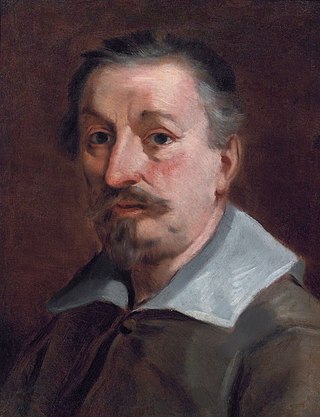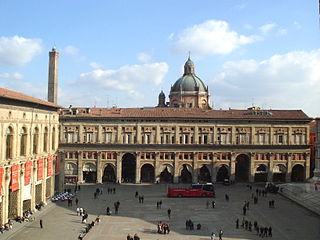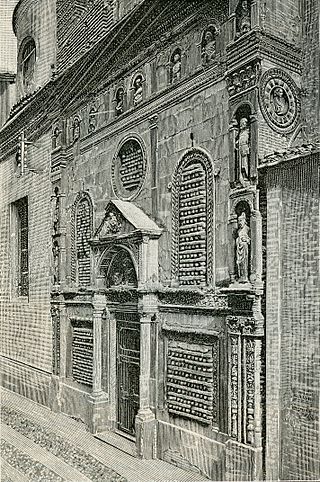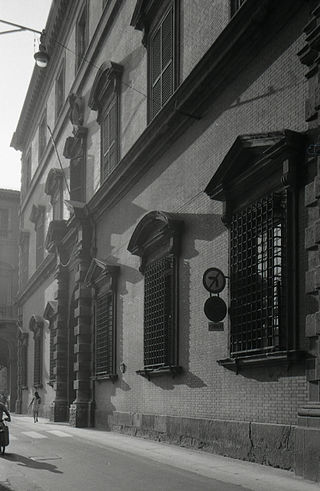
Francesco Albani or Albano was an Italian Baroque painter who was active in Bologna (1591–1600), Rome (1600–1609), Bologna (1609), Viterbo (1609–1610), Bologna (1610), Rome (1610–1617), Bologna (1618–1660), Mantova (1621–1622), Roma (1623–1625) and Florence (1633).

Vittorio Bigari was an Italian painter of the late-Baroque period.

The National Art Gallery of Bologna is a museum in Bologna, Italy. It is located in the former Saint Ignatius Jesuit novitiate of the city's University district, and inside the same building that houses the Academy of Fine Arts. The museum offers a wide collection of Emilian paintings from the 13th to the 18th century and other fundamental works by artists who were in some way related to the city.
Alfonso Torreggiani (1682–1764) was an Italian architect of the Rococo period, principally associated with Bologna.

The Basilica of San Giacomo Maggiore is an historic Roman Catholic church in Bologna, region of Emilia Romagna, Italy, serving a monastery of Augustinian friars. It was built starting in 1267 and houses, among the rest, the Bentivoglio Chapel, featuring numerous Renaissance artworks.

Palazzo Ghisilardi Fava is a Renaissance style palace, located on via Manzoni 4 in Bologna, region of Emilia Romagna, Italy; it houses the Medieval Civic Museum of Bologna.

Palazzo dei Banchi is a Renaissance-style palace façade located on the eastern flank of the Piazza Maggiore in the center of Bologna, region of Emilia-Romagna, Italy.

The Oratory of San Filippo Neri in Bologna is a restored late-Baroque religious structure in central Bologna. It is located on Via Manzoni. The Oratory was constructed from the sacristy of the adjacent church of the Madonna di Galliera. This church is now called Chiesa dei Filippini Madonna di Galliera e Filippo Neri.

The Palazzo Legnani Pizzardi, also known as Palazzo Pizzardi e Volta or just Palazzo Pizzardi, is a Renaissance style palace located on Via d'Azeglio #38, corner with Via Farini, in central Bologna, Italy. In 2015, the palace housed the Tribunal of Bologna.

Palazzo Malvezzi Campeggi is a Renaissance palace located on Via Zamboni number 22, at the corner (southwest) with Via Marsala, in central Bologna, region of Emilia Romagna, Italy. It stands across from San Giacomo Maggiore, and just northeast of the Palazzo Magnani. It presently houses the Law Faculty of the University of Bologna.

The Madonna di Galliera is a church with a Renaissance facade and Baroque interiors, located on Via Manzoni, in central Bologna, Italy. It stands in front of the Palazzo Ghisilardi Fava. The present name over the portal is the Chiesa di Filippini Madonna di Galliera e Filippo Neri.
Santa Maria Lacrimosa degli Alemanni is a small church and sanctuary, built during the Renaissance era, and located on Via Mazzini number 65 in central Bologna, Italy.

The Sanctuary of Santa Maria della Pioggia is a small church, located on Via Riva Reno 122, between Galliera road and Riva di Reno road in central Bologna, Italy. It was once the Oratory of San Bartolomeo di Reno.

The Palazzo Torfanini is a Renaissance architecture palace located on Via Galliera 4, in central Bologna. It is located near the Palazzo Aldrovandi. The palace, with typical facade arcades, was commissioned by Bartolomeo Torfanini in 1544.
Santa Maria Maggiore is a former Collegiate, Roman Catholic church, located on Via Galliera #10 in central Bologna, Italy. It is a house over from the Palazzo Aldrovandi.

Palazzo dei Convertendi is a reconstructed Renaissance palace in Rome. It originally faced the Piazza Scossacavalli, but was demolished and rebuilt along the north side of Via della Conciliazione, the wide avenue constructed between 1936 and 1950, which links St Peter's Basilica and the Vatican City to the centre of Rome. The palace is famous as the last home of the painter Raphael, who died there in 1520.

The Palazzo Isolani is a palace located on located on Via Santo Stefano #16 facing Piazza Santo Stefano in the center of Bologna, region of Emilia-Romagna, Italy, with both Gothic and Renaissance architecture features.

The Palazzo Caprara, also called Palazzo Galliera is a Renaissance-style urban palace located on Via IV Novembre #22 in central Bologna, region of Emilia-Romagna, Italy.

The Palazzo Malvezzi de' Medici is a Renaissance-style palace located on Via Zamboni #13 in central Bologna, Italy. The palace now houses the offices of the Provincial Administration.
The Palazzo Vizzani Lambertini Sanguinetti, sometimes known merely as Palazzo Vizzani is a Renaissance architecture palace located on Via Santo Stefano #43 in the center of Bologna, region of Emilia-Romagna, Italy. Presently the palace Houses the faculty of Foreign Languages and Literature of the University of Bologna.

















